Once in Liberia, we quickly forget about the troubles we had exiting Sierra Leone: the first immigration post, just after the bridge over the Mano river, is quite cool. “Welcome to Little America!” greets the officer. It is a tiny booth with a huge poster of the Real Madrid football team inside. There is also a poster of all the presidents of Liberia. I make a comment about the first ones, they look White. I am corrected by the officer: “Not white, but Afro-American freed slaves“, saying that some Liberians can be mistaken for White people, especially in Monrovia. I doubt it, but we’ll see … The borders officers are very good are boasting about their country. For example, they said with assurance there was no problems at the border with Ivory Coast since last year, when there has been recently.
Anyway, it is worth reading about the history of Liberia. Apart from the recent civil war and the diamond mining, there is much more in common with Sierra Leone. The land of the actual Liberia has been sparsely inhabited for a long time, as the forests and mangroves cover most of the country and prevented the development of large cities. And as usual, the Portuguese established the first trading posts in the XVth century, at the location of the actual Monrovia and Harper. From 1820, the American Colonization Society, an American organization that believed, not entirely for philanthropic reasons, that it was better for free slaves to be relocated to Africa, started to send Black American settlers to Liberia. They obtained the land by forcing a local king to sell Cape Mesurado (Monrovia) and were called Americo-Liberians. By 1847, the various colonies of free slaves settlers merged and declared independence. That makes Liberia one of the two countries out of 54 in Africa, with Ethiopia, to have never been colonized.

Today, Liberia calls himself the “little brother” of the USA (but this is not really a reciprocal relationship), has a very similar flag, Liberian dollars as currency (1 USD = 75 LD), has similar laws and a similar constitution, where the citizens must be “Negro or of Negro descent“. This later clause prevents the Lebanese, who “as usual” own all the large and successful shops and supermarkets in town, to own land and gain citizenship.
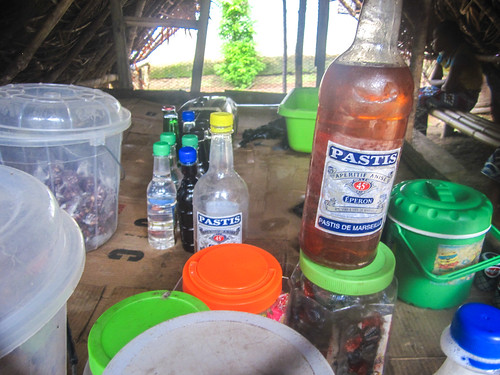
The initial good feeling of being in Liberia lasts only until the second immigration post, the one that stamps our passport. We both have a 90-day visa, acquired in Dakar for the modest sum of 150 USD. The officer is fair and polite but hands us our passport back with a “15 day stay” stamp. He says that he can only give us 15 days for now, and that we can get the rest of our 75 days, already paid for, at the immigration bureau in Monrovia, for free.
This sounds like a mean trick to make us pay twice but it is too late already, the passports are stamped. I really hope he is as honest as he looks.
The exchange rate of the money-changers in Bo-waterside are very bad. I don’t change my CFA Franc with them. So after changing the very few Sierra Leone leones left into Liberian dollars, hoping that this will last until Monrovia and the ATMs, we finally head on this very nice paved road. The sky is grey and the palm trees all over.
But no more than 15 km further, despite the rain and the fact we just got out of the very bad Sierra Leonean roads for a smooth tarmac, we re-engage for more toughness: we escape from the main road that would take us easily and smoothly until Monrovia within 2 days for a side visit to Robertsport.
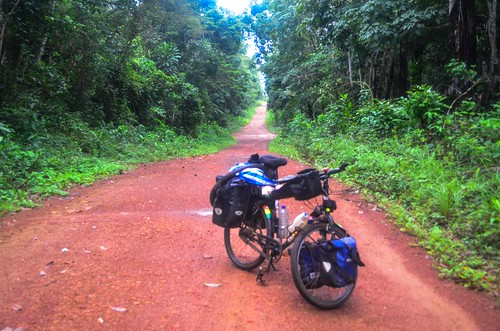
This smaller road is taking us to Robertsport, a town between the lake Piso and the ocean, before heading back to the main road. It is not paved and ends in Sawilor where we must take a boat. From various sources, I have read that the boat is not running but is replaced by canoes, and that during the rainy season, some parts of the road can be flooded by the ocean. Well, internet and books can never be accurate about Africa: nothing is regular and surprises, good and bad, happen all the time. The only consistency lies in the fact that everything is more difficult and slower during the rainy season.
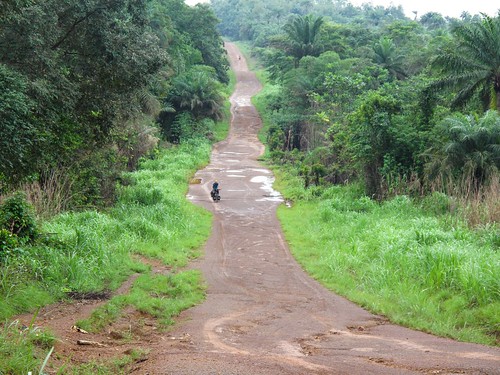
Before engaging too far on the road, at the Tiene crossroads, we ask to as many people as we can what is the situation in Sawilor. Is the boat running? Is it possible to cross anyway? And we receive as many different answers. It emerges that nobody really knows what is happening at the end of this road, 30 kilometers further.
There is a high risk that we must make a U-turn but we try it anyway.

The track is bad, as we have been used to, and the rain comes back, light at first. It rains harder and harder until we take refuge in a large school building, half finalized.

The classrooms are not completed yet but the furniture is already here. There is a beheaded snake in one of the rooms, but apart from that, the roofing is perfect and that will make a good shelter for the night.
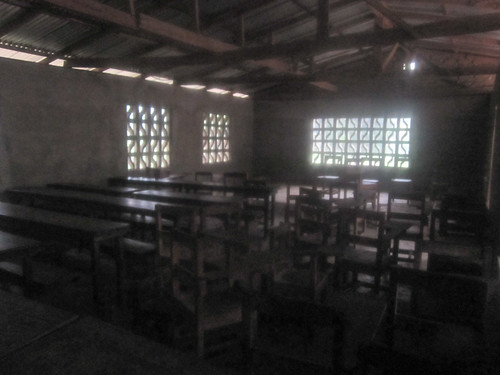
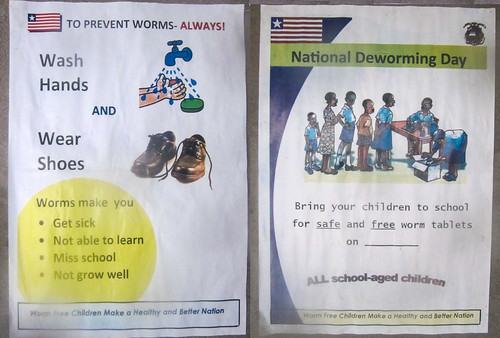
Once the rain intensity decreases, we head out of the school to ask the permission to the chief of the village or to the school principal. The school is very big for the small village nearby. We are directed towards the group of the wise men. One of them refuses that we sleep in the school and makes us stay instead in a brand new house that his brother just built. It is complete and only misses the furniture. It is right at the center of the village.
The people in the village are instructed to leave us alone. After a nice chat in the evening, they all leave us cooking and sleeping. Liberian English sounds to me like drunk English, but it is as least English, unlike the Sierra Leonean Krio. In the morning, they don’t come to “our” house until we finished to pack. Instead, the hundred of people are observing us from afar. There are not as many smiles as what I have been used to, but it has to be remembered that everyone older than 10 years old has known the war. And the people of Pujehun appear to be as respectful as hospitable.
This positive experience was perfect to transform my initial apprehension of visiting an unknown country into confidence. We thank our hosts and head to the boats for Robertsport.
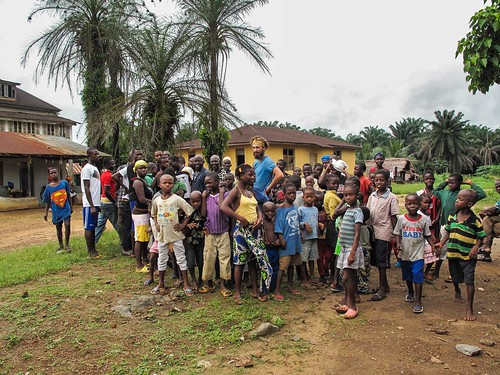
The small track continues into the dense forest. The sky is still grey and I spot a monkey on the way. We are stopped by a lady, that just wanted to kindly inform us that the boat is not running, but that the dugout canoes are transporting people to Robertsport for 150 LD per person. She also gives us the phone number of the owner of the boat in Robertsport in case we need his help. That is very fortunate and we head confidently towards Sawilor.


We finally arrive in Sawilor. This is a small town by the river Mafa. The roads ends here and there are a few canoes and villagers waiting. The buildings painted in blue stand out in the middle of the white sand.
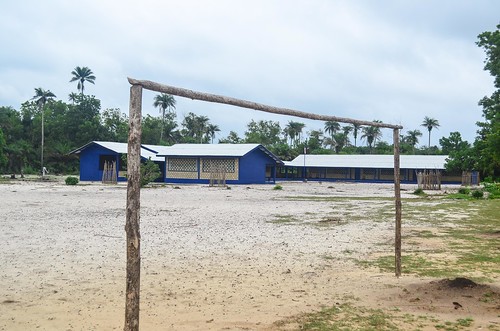
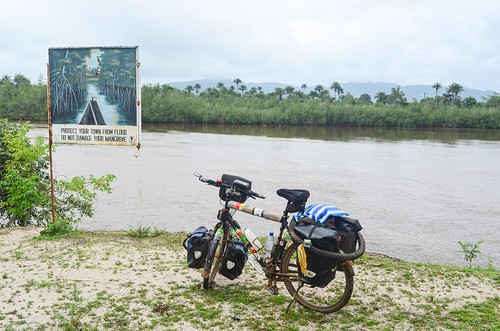
One of the men by the river agrees to take us to Robertsport. The dugout is big enough to load our bicycles safely. We are thinking of paying 150 LD (2 USD) each plus some extra for the bicycles.
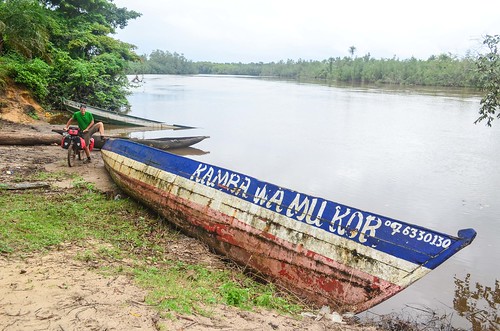
Once everything is loaded and ready, the dugout pilot wants 25 USD. He doesn’t want to discuss the price. We are sure this is not fair, but there is only one canoe available and all the villagers are behind this pilot … They support him with several arguments, making less and less sense, which in turn comfort us in thinking we are being abused. Well, this was easily foreseeable. We don’t even have this money, and this is why we want to quickly reach Robertsport, where the first bank is.
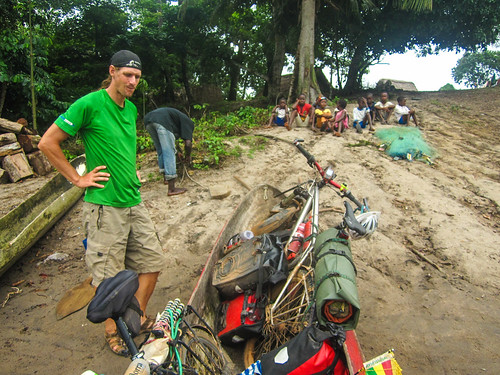
One of their arguments is that an American man was in the same situation a few days ago and he paid them 30 USD. As a result, all tourists and/or White people must pay the same … Whether this story is true or not, any wealthy White man in a hurry who agrees to pay 15 times the normal price is spoiling the experience for all the next travelers. This is the same with bribing at the border posts: there is no pride in doing it at all and it only makes things worse.
Since we refused the rip-off price and only offer 500 LD, which seem to us like a fair price, instead of 2000 LD asked, the traditional bluffing game starts: we tell them we would cycle back if they don’t want this money. The men leaves us with our stuff in the boat and return to their occupations. We have to either pay with money or time, and since we have time, we wait too. It starts drizzling and we are left in the village with the kids.
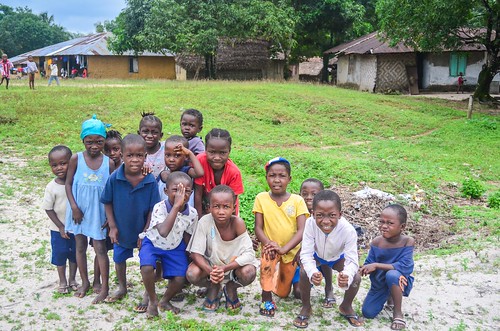
Johannes doesn’t want to pay the high price and is ready to cycle back the 30 km of dirt road. I don’t want to pay either but mostly I don’t want to stop here and make a U-turn. After the discussions (i.e. listening to the silly arguments), we have been waiting for one hour and there is no alternative. We are trapped and dependent on the few men there.
In a last attempt, I walk to the men, sitting at the center of the village. They are arguing together and seem even more annoyed by the waiting game than us. “Are you finally ready? Give us 600 LD and we go“, they say. I walk back to Johannes, wearing the smile of the denouement of the negotiations. But in the meantime, he has met someone willing to take us for 500 LD without further discussions. Since the canoe is ready, we leave immediately, happy to both leave behind us the group of men associated in extorting money, and to be doing a boat trip in the mangrove.
We must sit still at the bottom of the canoe and enjoy the ride calmly.
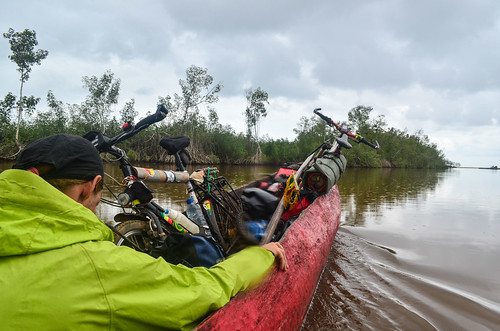
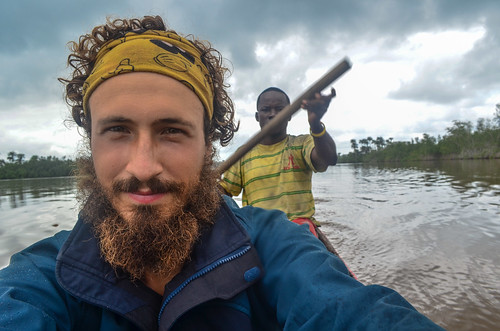
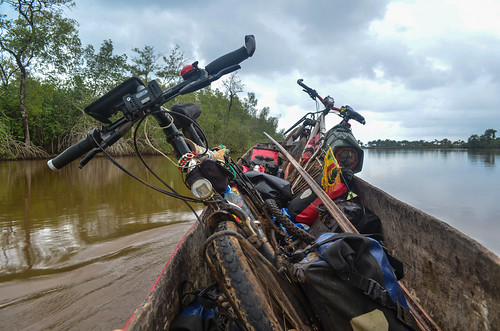
The ride lasts about 45 minutes. After the river, we arrive in Robertsport, on the shores of lake Piso. This tidal lagoon is the largest lake in Liberia. The trip is for us the only way to continue our journey, but it is also a pleasant cruise (once we are not afraid anymore of capsizing) in the mangrove and around the fishermen.

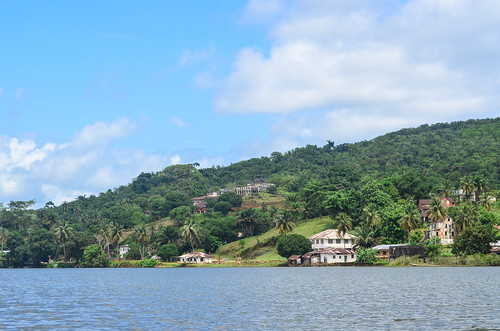

The drizzle stops and Robertsport welcomes us under a patch of blue sky. We rush to the LBDI bank, but there is no ATM. We have to change money, but they won’t take any other currency than USD. Same at the Fula shop. We must accept to use our emergency USDs.
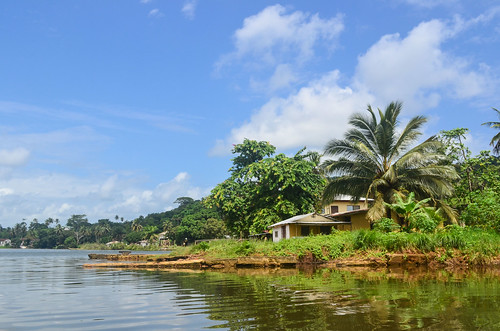
Robertsport is the capital of the Grand Cape Mount County. It is the first Liberian town of decent size (Pop. 3000+) we cross. It has been used as a military base for the Allied Forces during WW2 and is nowadays a (small) surfing resort and a getaway destination from Monrovia. We run into a UN compound and many UN cars.
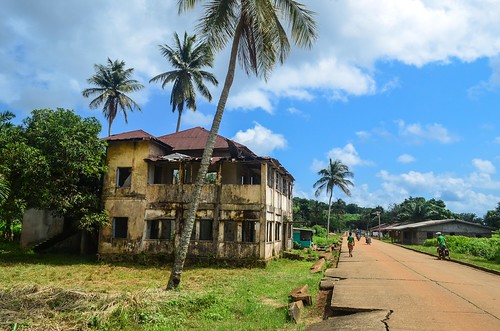
We are confused by the pricing system: both US dollars and Liberian dollars are used. It is not really written which currency is used, so since the ratio is significant (75 LD for 1 USD), we must guess. The petrol prices are written in USD per gallon. The restaurants serve food in LD. The credit for mobile phones are in USD. The fruits at the market are in LD. And in general, everything is much more expensive than in Sierra Leone (and anywhere else of West Africa so far).
I feel like we are cheated on, for bananas or for rice, but it is maybe the correct prices. My reference is now the oily flour donut, almost the same product since Guinea, with a consistent price. In Sierra Leone, a plate of rice was worth 4 to 6 donuts. It is 40 donuts in Robertsport (~3 USD), making the plate of rice worth almost ten times the 0.35€ it was in the previous countries. When the average Liberian live on 1 USD per day, those prices don’t make sense. Maybe the presence of the UN are locally inflating the prices?
It also makes me think about Senegal. While there, I was wondering how can people eat thiéboudienne every day. It was not bad, but the same rice, same vegetables and same fish at every meal … I got tired of it. Now that I have to cope with rice and kassava leaf sauce for every meal, for about the same price, I realize how good and rich is a thiéboudienne. If I think further, Morocco and its tagines with views on the mountains … were just a paradise.
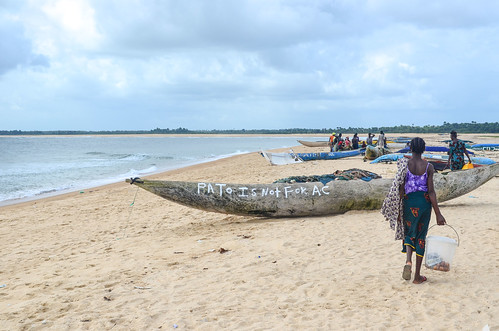
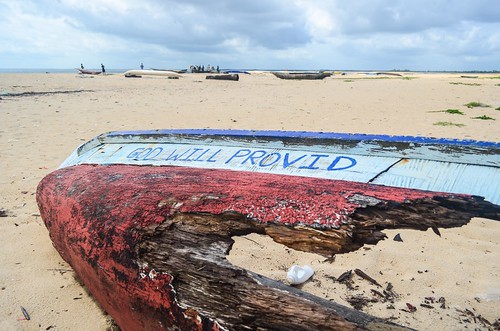
After food, the next priority is the lodging. The UN guys tell us the best and cheapest deal in Robertsport is the UN guesthouse, with rooms from 37 USD. We can’t believe it. How come such a country without infrastructure have Western prices? We find the actual cheapest accommodation, at 20 USD for a (very basic) room, in a simple building without electricity and water.
Everything sounds wrong in this place, the less attractive but the most expensive, so we agree on visiting what is not labelled in USD and leave. Practically, this is just cycling among the ruins.
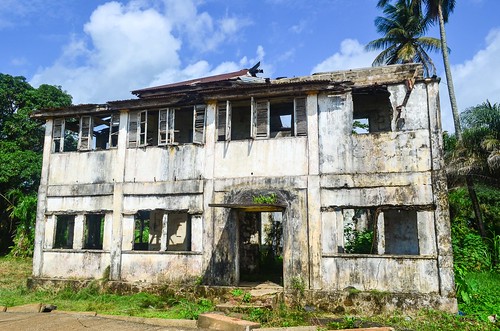
One set of ruins on the top of the town is very impressive and visible from the canoe in the lagoon. That is the Bethany Hall, on the Campus of St John Episcopal High School.

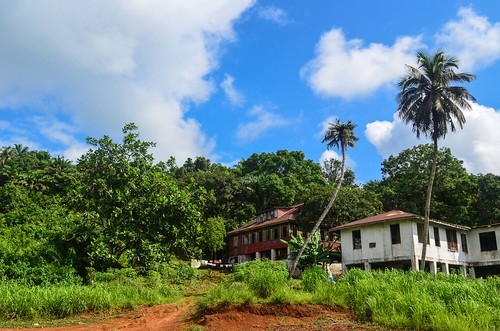

We manage to push our bikes up a dirt road washed away by the rain. It feels very special to have wonderful views of what could be a superb coastal resort, from the top of the ruins of a probably once impressive building. We are walking right in the glory of yesteryear.
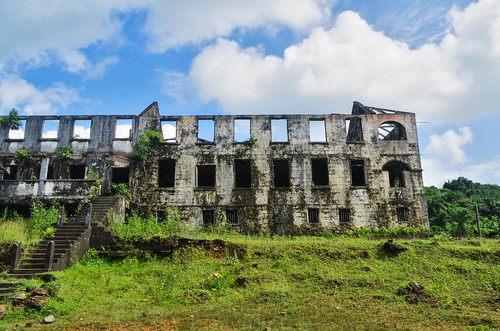
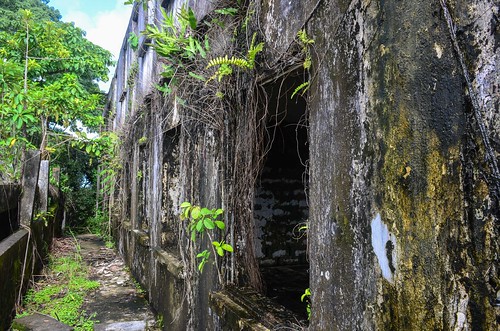

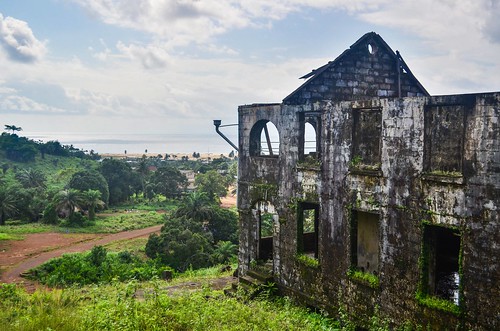
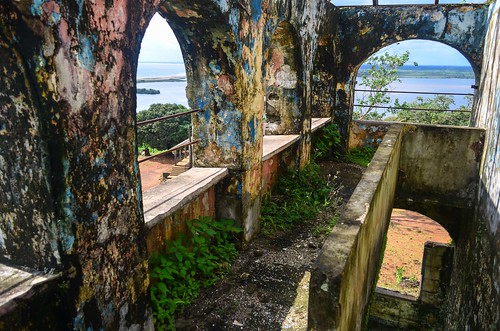

We spend the rest of the day cycling along the lake Piso towards Monrovia, under a light scattered rain. I see two kids carrying bottles containing worms or big larvas … which doesn’t remind me yet that we ate almost nothing since the morning.
But quickly after that, we need to eat, and we find in a village those oily fried flour donuts, the best deal for 5 L$. We continue until the village of Falie, recommended to us to spend the night. But it is already night and we are still cycling … until the first compound. I am not comfortable with camping by the lake shore, between the road and the lake, while it is raining already. We stop at the compound and ask to the caretakers, Lincoln and Janjay, if we can sleep under the roof of one of the many structures, but they offer us a spare room in their house. They have a 3-bedroom house just for them, which is quite a luxury considering they are “just” the guards. The large house of the compound must belong to an important personality then …
We cook our 500g of pasta outside when a crab pays us a visit among the usual insects. He looks at us, with eyes that would be meowing if it was a kitten. Somehow, a divine force sends a maggi-flavored spaghetto on his back. The crab starts cutting little pieces and brings them to his mouth with his claws. It is just as cute as kittens.
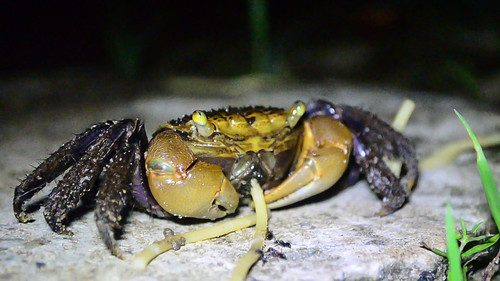
After only a minute, he learns how to suck it without using his claws, while ants are eating the other end of the spaghetto (the performance will be featured in a video to come alongside with Leo the scorpio and Gédéon the chameleon). A few centimeters of food later, he leaves us and returns to the lake. That makes our evening and we sleep warm on carpets while it rains outside.







Leave a Reply